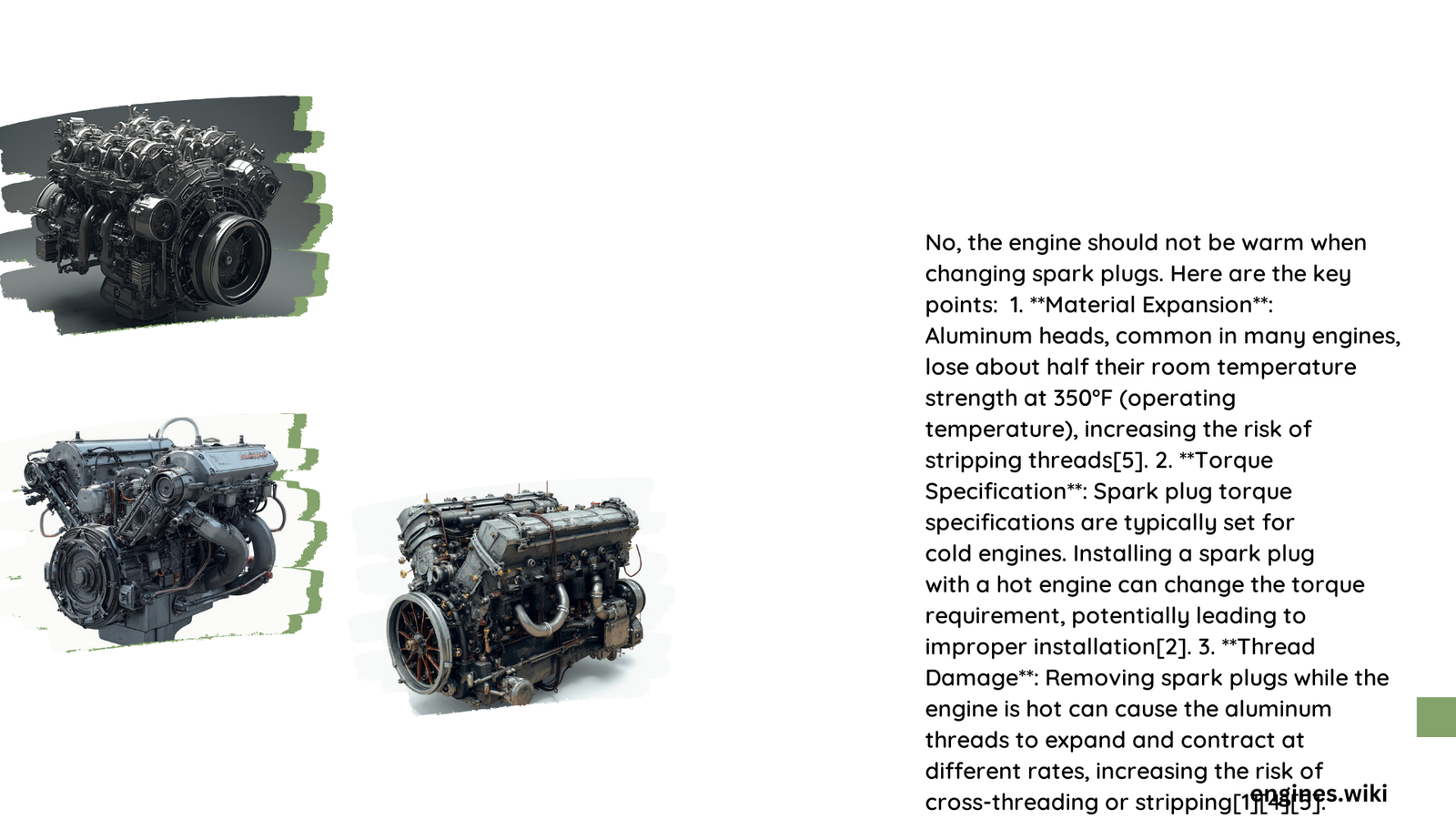Changing spark plugs is a crucial maintenance task for vehicle engines. The question of whether the engine should be warm or cold when performing this task is important for both safety and effectiveness. Generally, it is recommended to change spark plugs when the engine is cool to avoid potential damage and ensure proper installation. This article will explore the reasons behind this recommendation and provide detailed guidance on the correct procedure for changing spark plugs.
Why Is Engine Temperature Important When Changing Spark Plugs?
The temperature of the engine plays a significant role in the spark plug replacement process. Here’s why:
-
Thermal Expansion: Different materials expand and contract at varying rates when exposed to heat. The engine block (typically made of aluminum) and spark plugs (usually made of steel) have different thermal expansion coefficients.
-
Thread Integrity: When the engine is hot, the aluminum threads in the cylinder head expand more than the steel spark plug threads. This can lead to improper tightening or even thread damage during installation.
-
Safety Concerns: Working on a hot engine increases the risk of burns and injuries.
What Are the Risks of Changing Spark Plugs in a Hot Engine?

Changing spark plugs in a hot engine can lead to several problems:
- Thread Damage: The difference in thermal expansion between the cylinder head and spark plug can cause cross-threading or over-tightening.
- Improper Seating: Heat can affect the spark plug’s ability to seat correctly in the cylinder head.
- Burns: Hot engine components can cause serious burns if touched.
- Warped Spark Plugs: Rapid cooling of a hot spark plug by exposure to cooler air can potentially warp the plug.
What Is the Ideal Engine Temperature for Changing Spark Plugs?
The ideal temperature for changing spark plugs is when the engine is at ambient temperature. This means:
- The engine should be cool to the touch
- It should have been off for at least an hour (or more, depending on ambient conditions)
- The temperature of the engine should be similar to the surrounding air temperature
How Long Should You Wait Before Changing Spark Plugs?
The waiting time can vary depending on several factors:
| Factor | Recommended Waiting Time |
|---|---|
| Ambient Temperature | 1-2 hours in moderate climates |
| Engine Size | Larger engines may require longer cooling times |
| Recent Engine Operation | Longer wait times if the engine was running at high temperatures |
| Material of Engine Block | Aluminum engines cool faster than cast iron |
As a general rule, waiting at least 2 hours after the engine has been turned off is a safe approach.
What Are the Steps to Properly Change Spark Plugs in a Cool Engine?
Follow these steps to change spark plugs correctly:
- Ensure the engine is cool to the touch
- Locate the spark plugs (consult your vehicle’s manual if unsure)
- Remove any debris around the spark plug wells
- Disconnect the spark plug wires or coil packs
- Use a spark plug socket to remove the old plugs
- Check the gap on the new spark plugs and adjust if necessary
- Insert the new spark plugs by hand to avoid cross-threading
- Use a torque wrench to tighten to the manufacturer’s specifications
- Reconnect the spark plug wires or coil packs
- Start the engine to ensure proper operation
Are There Any Exceptions to the Cool Engine Rule?
While it’s generally best to change spark plugs in a cool engine, there are rare exceptions:
- Emergency Situations: In extreme cases where immediate replacement is necessary, extra caution must be taken to avoid burns and ensure proper installation.
- Professional Settings: Some mechanics with extensive experience may work on warm engines, but this is not recommended for DIY enthusiasts.
What Tools Are Needed for Changing Spark Plugs?
To change spark plugs effectively, you’ll need:
- Spark plug socket
- Ratchet and extension
- Torque wrench
- Gap tool (if adjusting spark plug gaps)
- Anti-seize compound (optional)
- Dielectric grease (for spark plug boots)
How Can You Ensure Proper Spark Plug Installation?
To ensure proper installation:
- Use the correct spark plugs for your vehicle
- Check and set the correct gap
- Avoid over-tightening (use a torque wrench)
- Apply a small amount of anti-seize compound to the threads (if recommended by the manufacturer)
- Ensure the spark plug is seated correctly before final tightening
What Are Common Mistakes to Avoid When Changing Spark Plugs?
Common mistakes include:
- Changing plugs when the engine is hot
- Over-tightening or under-tightening
- Using the wrong type of spark plug
- Damaging the spark plug wires or coil packs during removal
- Dropping debris into the cylinder when the plug is removed
- Forgetting to gap the plugs (if required)
How Often Should Spark Plugs Be Changed?
The frequency of spark plug changes depends on:
- Vehicle make and model
- Type of spark plugs (copper, platinum, iridium)
- Driving conditions
Most modern vehicles with long-life spark plugs can go 60,000 to 100,000 miles before needing replacement. Always consult your vehicle’s owner manual for specific recommendations.
In conclusion, changing spark plugs in a cool engine is the safest and most effective approach. It minimizes the risk of damage to both the engine and the spark plugs while ensuring proper installation. By following the correct procedures and taking the necessary precautions, you can maintain your engine’s performance and longevity.
References:
1. NGK Spark Plugs – Tech Info
2. Champion Auto Parts – Spark Plug Installation
3. Bosch Auto Parts – Spark Plug Replacement Guide
